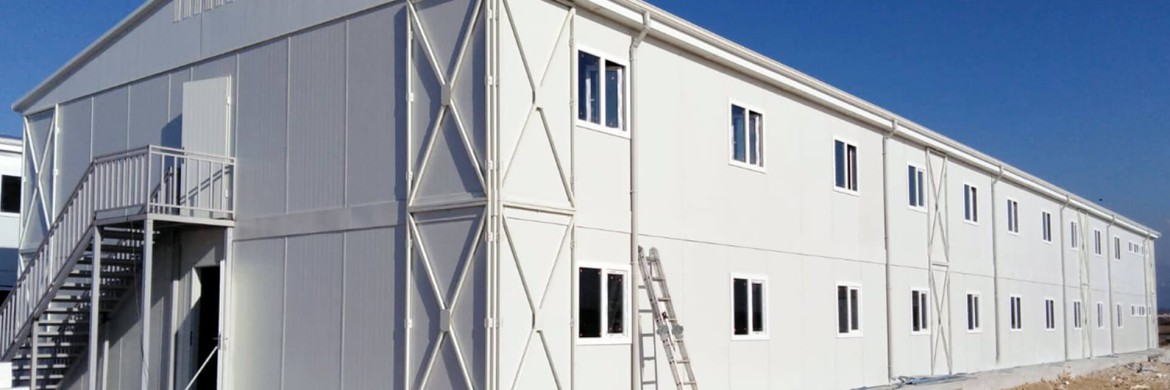What is Hybrid Modular Construction? A Modern Building Solution
Hybrid modular construction offers a revolutionary approach that blends off-site prefabrication with traditional on-site methods, delivering faster, more efficient, and sustainable building solutions for modern construction needs.
What is Hybrid Modular Construction?
Hybrid modular construction refers to a building approach that combines traditional on‑site construction techniques with off‑site prefabricated components. In this approach, structural elements like steel frames concrete may be assembled on‐site, while other parts—rooms, whole walls, bathroom pods are manufactured off‐site in a factory and then transported to the site for installation. The goal is to leverage the benefits of both conventional construction and off‑site fabrication, improving speed, quality, and cost control. Hybrid modular construction system emphasizes precision and repeatability from factory production while still allowing the flexibility and adaptability of in‑situ building.
Modular construction more broadly describes building methods where large components or entire modules are produced in a controlled environment, then transported and assembled on location. While pure module‑based projects might deliver full units, hybrid versions mix modules with site‑built parts. That allows developers to handle site constraints, regulatory requirements, or complex geometries that may not suit entirely modular approaches. In essence, hybrid methods bridge the gap between full modular builds and traditional construction.
How Does Hybrid Modular Construction Work?
The process begins with detailed design and coordination. Architects and engineers plan which parts of the building will be factory‑built modules, and which will be constructed on‑site. This planning must consider transportation logistics, size constraints of modules, local building codes, and connection points between modular and site‑built components.
Next, modules are manufactured in a factory environment. These may include full room units bathrooms, kitchens or structural panels, whereas other structural elements like beams, floor slabs, or columns are erected on‐site. The hybrid modular construction system includes quality control, precise tolerances, and often integrated utilities pre-installed within modules.
Once modules are completed, they are transported to the construction site. Cranes or lifting devices position them onto the site‑built frame or foundation. On‐site work includes assembling structural parts, joining the modules, sealing joints, connecting utilities, finishing facades, roofing, and ensuring structural integration. Coordination is vital at interfaces where prefabricated modules meet site‑built sections, especially for mechanical, electrical, and plumbing systems and weatherproofing.
What Are the Advantages of Hybrid Modular Construction?
Hybrid modular construction offers several key advantages. First, speed of construction improves significantly because modules can be built in parallel with site‑preparatory work. For example, foundation work onsite can proceed while modules are being fabricated elsewhere. This overlap reduces total project timeline.
Second, factory conditions often lead to higher quality and consistency. Controlled environments reduce exposure to weather delays and allow better supervision of workmanship. Modules are often finished with interior components, fixtures, and utility hookups before transportation, ensuring less rework post‑installation.
Third, cost predictability improves. Since a large portion of building is standardized in modules, materials can be purchased in bulk, labor costs in factory settings are more stable, and risks of onsite surprises are reduced. That helps with budget control.
Fourth, waste reduction is another benefit. Prefabrication allows more efficient material usage, and leftover materials can be recycled or reused within the factory. On‑site waste tends to be minimized. Also, safety is often better in factories than open sites, reducing accidents and delays.
What Types of Buildings Can Use Hybrid Modular Construction Systems?
Large variety of building types can benefit from this approach. Residential projects like apartment blocks, student housing, dormitories, and hotels often adopt hybrid methods. These building types frequently require repeated layouts and benefit from module reuse and standardized design.
Commercial buildings such as offices, retail spaces, or mixed‑use developments may also apply hybrid modular techniques. Components like restrooms, service cores, façade panels, or roof structures can be prefabricated as modules and integrated with site‑built wings.
Educational facilities, healthcare buildings, and healthcare complexes are also suitable because they often need high standards of quality, quick construction times, and controlled indoor environments. For places with challenging access or remote locations, transporting modules and assembling them on‑site reduces on‑site labor needs.
Container Based Modules
Container based modules refer to using shipping containers or container‑like structures as standardized modules. These are repurposed or custom fabricated containers that are modified in factory to include windows, insulation, plumbing, and finishes. They can be transported easily and stacked or combined with on‑site structural elements. Container modules are especially useful for temporary structures, emergency housing, or modular dwellings where robustness and mobility are important. The container form factor provides strong enclosure and ease of handling, though integration with site‑built parts must carefully address connections, insulation, and building codes.
Prefabricated Structural Modules
Prefabricated structural modules are larger factory‑built sections that include framing, floors, walls, sometimes even full rooms, with structural capacity built in. These modules can be steel frames, timber panels, or concrete volumetric units. In hybrid buildings, these modules are combined with traditional foundations, core structural elements, or site‑built additions. The modules arrive ready for connection, and once on‑site they are anchored, sealed, and connected with utilities. This type of module supports rapid assembly and high quality finishes, simplifying coordination where precision matters.
Is Hybrid Modular Construction Sustainable?
Hybrid modular construction offers strong sustainability benefits. The factory environment allows better waste management: materials can be measured precisely, leftover materials reused, and redundant components minimized. Energy efficiency is higher both in module manufacturing and in the operational performance of modules: tight joints, controlled finishing, insulation and reduced thermal bridging contribute to lower energy consumption in heating and cooling.
Additionally, because construction time is shorter, environmental disruption on‑site is reduced—less noise, dust, and disturbance. Transportation impacts exist due to moving modules, but overall life‑cycle assessment tends to favor hybrid approaches, especially when modules are designed for longevity, reuse, or disassembly. Also, hybrid systems can facilitate reuse of modules or components, enhancing circularity.
How Long Do Hybrid Modular Construction Last?
With good design, materials, and craftsmanship, buildings constructed using hybrid modular techniques can last as long as traditionally built structures. Structural elements steel, concrete, timber (when properly treated) all have well‑established durability profiles. Modules themselves, being built in controlled conditions, often avoid issues like moisture ingress during construction, which can otherwise degrade longevity.
Maintenance over decades ensures life span. Foundations, structural frames, and external cladding need regular inspection, just as with any building. If designed for adaptability, portions of the modular elements might be replaced or upgraded without tearing down the whole building, further extending service life. In many cases, expected lifespans of 50 to 100 years are achievable, depending on environment, materials, and maintenance regime.
How Durable Are Hybrid Modular Construction?
Durability stems from both material quality and precision in manufacture. Because modules are fabricated indoors, moisture, weather, and temperature swings are less likely to cause defects during construction. Connections between modules and site‑built elements, however, are critical weak points: proper sealing, alignment, tolerance control and structural anchoring must be well engineered.
Durable cladding, moisture barriers, quality insulation, and corrosion protection for metal parts all contribute. In harsh climates, attention to thermal movement, UV resistance, wind loads, and seismic design also matter. When components are properly specified and connected, hybrid modular construction is very capable of long‐term durability similar to conventional construction.
Is Maintenance of Hybrid Modular Buildings Easy?
Maintenance of buildings built using this approach tends to be easier in certain respects. Since many modules include fully finished interior spaces or pre‑installed utilities, problems are easier to isolate: a faulty bathroom pod or kitchen module might be accessed or replaced with less disruption compared to fixing those elements in a wholly site‑built structure. Also, factory construction tends to produce fewer defects, reducing repair work after completion.
That said, maintenance at the joints where prefabricated modules meet on‑site components can require more vigilance. Sealants, flashing, connections and weatherproofing at interfaces must be inspected, because failure there can lead to leaks or structural compromise. Also, modules transported may see stresses in transport, so ensuring adequate protection during transport and installation is part of the long‑term maintenance strategy. Overall, upkeep is comparable to, or in some cases easier than, traditional methods.
What is the Future of Hybrid Modular Construction?
Looking ahead, hybrid modular construction is likely to become more widespread. Advances in digital design tools, Building Information Modeling (BIM), and robotics will improve precision, reduce cost, and enable even more complex hybrid designs. Materials innovation lighter composites, more durable composites, cross‑laminated timber, improved insulation will enhance sustainability and performance.
Regulatory and zoning environments may adapt to better accommodate modules, simplifying permits for off‑site built components. Also, supply chains will mature, as manufacturers and logistics providers specialize in module transportation, storage, and on‑site assembly.
In summary, hybrid modular construction is a modern building solution combining the efficiency of off‑site modular fabrication with the adaptability of on‑site methods. Appropriate for many building types, it offers speed, quality, sustainability, durability, and a promising future as construction evolves.

